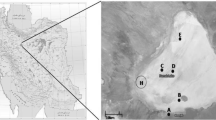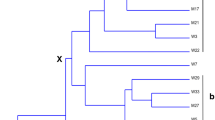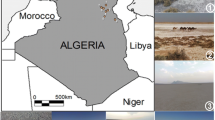Abstract
Since discovery, the halophilic archaeal and bacterial strains were studied for their unique compounds such as pigments, proton pumps, compatible solutes and enzymes. Due to their tolerance to extreme salinities several research on using these organisms in various fields is conducted worldwide. Though sequencing is an efficient way of identifying an organism, the difficulty of selecting an optimal archaea primer for identification of archaea is tedious. Therefore, it is essential to discriminate them as bacteria or archaea before going for sequencing studies. There are several conventional and analytical techniques followed in discriminating and identifying the halophilic archaea and bacteria. The present study is an investigation of various conventional and analytical techniques such as morphological observations, biochemical tests, salinity optima, chloramphenicol susceptibility, growth in sodium taurocholate, lipid profiling by FAME analysis, FTIR and sequencing technique used in identifying halophilic community. This study also explains the disadvantages of each analysis and confirms the tests that can be used in the preliminary confirmation of halophilic archaea or bacteria. In the present study, halophilic archaeal and bacterial community from Solar salterns of Kelambakkam, Chennai, Tamilnadu and Tuticorin, Tamilnadu and Salt evaporation tank of tannery, Vellore, Tamilnadu were isolated and studied by various above-mentioned techniques. From the study, it was identified that FAME analysis out of other analyses can be used as preliminary method to identify and also distinguish the halophilic archaea and bacterial community.




Similar content being viewed by others
REFERENCES
Artari, A., Zur Physiologic der Chlamydomonaden. Versuche und Beobachtungen an Chlamydomonas ehrenbergii Gorosch. und verwandten Formen, Jb. Wiss. Bot., 1913, vol. 52, pp. 410–466.
Ashwini, R., Vijayanand, S., and Hemapriya, J., Photonic potential of haloarchaeal pigment bacteriorhodopsin for future electronics: a review, Curr. Microbiol., 2007, vol. 74, no. 8, pp. 996–1002. https://doi.org/10.1007/s00284-017-1271-5
Baas Becking, L.G.M., On organisms living in concentrated brine, Tijdschr Ned Dierk Ver Ser III, 1928, vol. 1, pp. 6–9.
Baati, H., Guermazi, S., Gharsallah, N., Sghir, A., and Ammar, E., Novel prokaryotic diversity in sediments of Tunisian multipond solar saltern, Res. Microbiol., 2010, vol. 161, no. 7, pp. 573–582.
Bahram, M., Anslan, S., Hildebrand, F., Bork, P., and Tedersoo, L., Newly designed 16S rRNA metabarcoding primers amplify diverse and novel archaeal taxa from the environment, Environ. Microbiol. Rep., 2019, vol. 11, pp. 487–494. https://doi.org/10.1111/1758-2229.12684
Belmok, A., Rodrigues-Oliveira, T., Lopes, F.A.C., Krüger, R.H., and Kyaw, C.M., The influence of primer choice on archaeal phylogenetic analyses based on 16S rRNA gene PCR, Braz. J Biol., 2021, vol. 83.
Bonfa, M.R., Grossman, M.J., Mellado, E., and Durrant, L.R., Biodegradation of aromatic hydrocarbons by Haloarchaea and their use for the reduction of the chemical oxygen demand of hypersaline petroleum produced water, Chemosphere, 2011, vol. 84, pp. 1671–1676.
Boujelben, I., Martinez-Garcia, M., Pelt, J., and Maalej, S., Diversity of cultivable halophilic archaea and bacteria from superficial hypersaline sediments of Tunisian solar salterns, Antonie van Leeuwenhoek, 2014, vol. 106, pp. 675–692, https://doi.org/10.1007/s10482-014-0238-9
Chaban, B. and Hill, J.E., A ‘universal’ type II chaperon in PCR detection system for the investigation of Archaea in complex microbial communities, ISME J., 2012, vol. 6, no. 2, pp. 430–439.
Cuadros-Orellana, S., Pohlschröder, M., Grossman, M.J., and Durrant, L.R., Biodegradation of aromatic compounds by a halophilic archaeon isolated from the Dead Sea., Chem. Eng. Trans., 2012, vol. 27, pp. 13–18.
Delgado-García, M., De la Garza-Rodríguez, I., Cruz-Hernández, M.A., Balagurusamy, N., Aguilar, C., and Rodríguez-Herrera, R., Characterization and selection of halophilic microorganisms isolated from Mexican soils, J. Agric. Biol. Sci., 2013, vol. 8, no. 6, pp. 457–464.
Dereeper, A., Guignon, V., Blanc, G., Audic, S., Buffet, S., Chevenet, F., Dufayard, J.F., Guindon, S., Lefort, V., Lescot, M., and Claverie, J.M., Phylogeny. fr: robust phylogenetic analysis for the non-specialist, Nucleic Acids Res., 2008, vol 36. no. 2, pp. W465–W469.
Emerson, D., Agulto, L., Liu, H., and Liu, L., Identifying and characterizing bacteria in an era of genomics and proteomics, BioSci., 2008, vol. 58, no. 10, pp. 925–936.
Enache, M., Itoh, T., Kamekura, M., Popescu, G. and Dumitru, L., Halophilic archaea of Haloferax genus isolated from anthropocentric Telega (Palada) salt lake, Proc. Rom. Acad. B, 2006, vols. 1–2, pp. 11–16.
Franze, M., and Cherkouk, A., Isolation and Characterization of Extreme Halophilic Archaea, HZDR, Institute of Resource Ecology, Annual Report, 2016, р. 52.
Fukushima, T.T., Usami, R., and Kamekura, M., A traditional Japanese-style salt field is a niche for haloarchaeal strains that can survive in 0.5% salt solution, Saline Syst., 2007, vol. 3, no. 1, pp. 1–12.
Gomes, J. and Steiner, W., The biocatalytic potential of extremophiles and extremozymes, Food Technol. Biotechnol., 2004, vol. 42, pp. 223–235.
Guillén-Cruz, R., Hernández-Castillo, F.D., Gallegos-Morales, G., Rodríguez-Herrera, R., Aguilar-González, C.N., Padrón-Corral, E., and Reyes-Valdés, M.H., Bacillus spp. as biocontrol in an infested soil with Fusarium spp., Rhizoctonia solani Kühn, and Phytophthora capsici Leonian, and its effect on development and yield of pepper crop (Capsicum annuum L.), Rev. Mex. Fitopatol., 2006, vol. 24, no. 2, pp. 105–114.
Güven, K.Y., ah Albayrak, G., Güven, A., and YazÄc, B., FT-IR for rapid discrimination of halophilic archaea and bacteria, J. Phylogenet. Evol. Biol., 2015. https://doi.org/10.4172/2329-9002.1000147
Hassanshahian, M. and Mohamadian, J., Isolation and characterization of Halobacterium salinarum from saline lakes in Iran, Jundishapur J. Microbiol., 2011, vol. 4, no. 1, pp. S59–S65.
Irshad, A., Ahmad, I., and Kim, S.B., Isolation, characterization and antimicrobial activity of halophilic bacteria in foreshore soils, Afr. J Microbiol. Res., 2013, vol. 7, no. 3, pp.164–173.
Johnson, A.M., Thurlow, L.R., Zwenger, S.R., and Gillock, E.T., Partial characterization of two moderately halophilic bacteria from a Kansas salt marsh, Prairie Nat., 2007, vol. 39, no. 1.
Kamekura, M., Oesterhelt, D., Wallace, R., Anderson, P., and Kushner, D.J., Lysis of halobacteria in bacto-peptone by bile acids, Appl. Environ. Microbiol., 1988, vol. 54, no. 4, pp. 990–995.
Kamekura, M., and Seno, Y., Lysis of halobacteria with bile acids and proteolytic enzymes of halophilic archaeobacteria, General and Applied Aspects of Halophilic Microorganisms, Boston, MA: Springer, 1991, pp. 359–365.
Karthikeyan, P., and Chandrasekaran, M., Studies on Halocin production by haloarchaea Natrinema sp. BTSH10, Doctoral Dissertation, Cochin University of Science and Technology, 2013.
Klindworth, A., Pruesse, E., Schweer, T., Peplies, J., Quast, C., Horn, M., and Glöckner, F.O., Evaluation of general 16S ribosomal RNA gene PCR primers for classical and next-generation sequencing-based diversity studies, Nucleic Acids Res., 2013, vol. 41, no. 1, e1–e1.
Kumar, S., Karan, R., Kapoor, S., Singh, S.P., and Khare, S.K., Screening and isolation of halophilic bacteria producing industrially important enzymes, Braz. J. Microbiol., 2012, vol. 43, pp. 1595–1603.
Kushner, D.J., and Kamekura, M. Physiology of halophilic eubacteria, Halophilic Bact., 1988, pp. 109–138.
Larsen, H., The halobacteria’s confusion to biology, The fourth A.J. Kluyver memorial lecture, Antonie van Leeuwenhoek, 1973, vol. 39, pp. 383–396.
Litchfield, C.D., Halophiles, J. Ind. Microbiol. Biotechnol., 2002, vol. 28, no. 1, pp. 21–22.
Mahmoudnia, F., Bahador, N., and Baserisalehi, M., Isolation, characterization and identification of amylase producing halothermophilic isolates from Howz Soltan Lake, Iran, Afr. J. Microbiol. Res., 2013, vol. 7, no. 36, pp. 4483–4490.
Mani, K., Salgaonkar, B.B., and Braganca, J.M., Culturable halophilic archaea at the initial and crystallization stages of salt production in a natural solar saltern of Goa, India, Aquat. Biosyst., 2012, vol. 8, no. 1, pp. 1–8.
Maturrano, L., Santos, F., Rosselló-Mora, R., and Antón, J., Microbial Diversity in Maras Salterns, a Hypersaline Environment in the Peruvian Andes, Appl. Environ. Microbiol., 2006, vol. 72, no. 6, pp. 3887–3895.
Montalvo-Rodríguez, R., Lopez-Garriga, J., Vreeland, R.H., Oren, A., Ventosa, A., and Kamekura, M., Haloterrigena thermotoleran ssp. nov., a halophilic archaeon from Puerto Rico, Int. J. Syst. Evol. Microbiol., 2000, vol. 50, no. 3, pp. 1065–1071.
Moschetti, G., Aponte, M., Blaiotta, G., Casaburi, A., Chiurazzi, M., Ventorino, V., and Villani, F., Characterization of halophilic Archaea isolated from different hypersaline ecosystems, Ann. Microbiol., 2006, vol. 56, no. 2, pp. 119–127.
Oh, D., Porter, K., Russ, B., Burns, D., and Dyall-Smith, M., Diversity of Haloquadratum and other haloarchaea in three, geographically distant, Australian saltern crystallizer ponds, Extremophiles, 2010, vol. 14, no. 2, pp. 161–169.
Oren, A., and Litchfield, D.C., A procedure for the enrichment and isolation of Halobacterium, FEMS Microbiol. Letts., 1999, vol. 173, pp. 353–358.
Oren, A., Duker, S., and Ritter, S., The polar lipid composition of Walsby’s square bacterium, FEMS Microbiol. Lett., 1996, vol. 138, nos. 2–3, pp. 135–140.
Oren, A., The dying Dead Sea: The microbiology of an increasingly extreme environment, Lake Reserv. Res. Manage., 2010, vol. 15, no. 3, pp. 215–222.
Ozcan, B., Cokmus, C., Coleri, A., and Caliskan, M., Characterization of extremely halophilic archaea isolated from saline environment in different parts of Turkey, Microbiol., 2006, vol. 75, no. 6, pp. 739–746.
Sahay, H., Singh, S., Kaushik, R., Saxena, A., and Arora, D., Characterization of halophilic bacteria from environmental samples from the brackish water of Pulicat Lake, India, Biologia, 2011, vol. 66, no. 5, pp. 741–747.
Sarma, S.D. and Sarma, P.D., Halophiles, Chichester: Wiley, 2012. https://doi.org/10.1002/9780470015902.a0000394.pub3
Sasser, M., Bacterial identification by gas chromatographic analysis of fatty acids methyl esters (GC–FAME), Technical Note no. 101, New York, NY: MIDI-Inc., 2006.
Semenov, M.V., Manucharova, N.A., and Stepanov, A.L., Distribution of metabolically active prokaryotes (Archaea and Bacteria) throughout the profiles of chernozem and brown semidesert soil, Eurasian Soil Sci., 2016, vol. 49, no. 2, pp. 217–225.
Sun, D.L., Jiang, X., Wu, Q.L., and Zhou, N.Y., Intragenomic heterogeneity of 16S rRNA genes causes overestimation of prokaryotic diversity, Appl. Environ. Microbiol., 2013, vol. 79, no. 19, pp. 5962–5969. https://doi.org/10.1128/AEM.01282-13
Surve, V.V., Patil, M.U., and Dharmadhikari, S.M., FAME and 16S rDNA sequence analysis of halophilic bacteria from solar salterns of Goa: a comparative study, Int. J. Sci. Res. Publ., 2012, vol. 2, no. 8, pp. 1–8.
Vijayanand, S., Hemapriya, J., Selvin, J., and Kiran, S., Production and optimization of haloalkaliphilic protease by an extremophile—Halobacterium sp. JS1, isolated from thalassohaline environment, Afr. J. Basic Appl. Sci., 2009, vol. 1, nos. 3–4, pp. 49–54.
Woese, C.R. and Fox, G.E., Phylogenetic structure of the prokaryotic domain: the primary kingdoms, Proc. Natl. Acad. Sci. U. S. A., 1977, vol. 74, pp. 5088–5090.
Yildiz, E., Ozcan, B., and Caliskan, M., Isolation, characterization and phylogenetic analysis of halophilic Archaea from a salt mine in central Anatolia (Turkey), Pol. J. Microbiol., 2012, vol. 61, no. 2, pp. 111–117.
Yim, K.J., Kwon, J., Cha, I.T., Oh, K.S., Song, H.S., Lee, H.W., Rhee, J.K., Song, E., Rho, J.R., Seo, M.L., Choi, J.S., Choi, H.J., Lee, S.J., Nam, Y.D., and Roh, S.W., Occurrence of viable, red-pigmented haloarchaea in the plumage of captive flamingos, Sci. Rep., 2015, vol. 5, no. 1, pp. 1–10. https://doi.org/10.1038/srep16425
Author information
Authors and Affiliations
Corresponding author
Ethics declarations
The authors declare that they have no conflicts of interest. This article does not contain any studies involving animals or human participants performed by any of the authors.
Rights and permissions
About this article
Cite this article
Ashwini Ravi, Vijayanand, S. & Hemapriya, J. Compilation of Analytical Techniques for Discrimination of Halophilic Archaea and Bacteria. Biol Bull Russ Acad Sci 49 (Suppl 1), S39–S50 (2022). https://doi.org/10.1134/S1062359022130167
Received:
Revised:
Accepted:
Published:
Issue Date:
DOI: https://doi.org/10.1134/S1062359022130167




